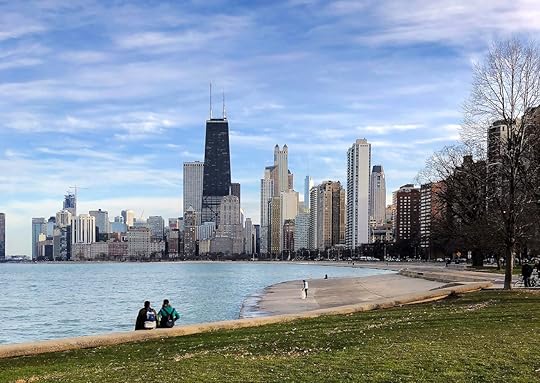Matador Network's Blog, page 1123
April 10, 2019
Gardening can help you be healthier

If you’re one of those people who’s always postponing your gym sessions, now you may actually be able to postpone them indefinitely. According to a new study conducted by researchers around the world, “leisure time physical activity” can actually be a great substitute to the dreaded leg day, or an hour on the treadmill. “Leisure time physical activity” can include a wide range of activities, like gardening, dancing, and even just going for a walk. Compared to a sedentary lifestyle, doing these activities for just 10 to 59 minutes a week was proven to lead to an 18 percent lower risk of all-cause mortality — including cardiovascular disease and cancer.
The study took place over 11 years, involved nearly 90,000 participants, and used data from 12 National Health Interview Surveys organized by the Centers for Disease Control and Prevention.
The idea that gardening could be linked to health benefits isn’t a revolutionary idea. Previous studies have found that gardening is associated with a decrease in depression, anxiety, and body mass index, along with increases in quality of life, life satisfaction, sense of community.
While gardening might be a solid gym substitute in the spring and summer, however, you’ll need to find another “leisure time physical activity” to keep yourself occupied during the cold winter months. 
H/T: Travel & Leisure

More like this: How to stay committed to your health and wellness goals while traveling
The post Ditch the gym: study shows that gardening can keep you healthy, too appeared first on Matador Network.

Mary Berry hosting an afternoon tea

Afternoon tea is a quintessential British experience, but sharing the mini sandwiches and pastries with beloved Mary Berry — the TV personality known for judging The Great British Baking Show — has to be almost as good as sharing crumpets with the Queen. In partnership with excursions company Belmond, Berry is hosting an afternoon tea train ride from Victoria Station in London through the picturesque Weald of Kent in the southeastern corner of the country. The four-hour round-trip journey through this area of woods and valleys won’t take place on just any commuter rail, but on a British Pullman train from the ‘20s.

Photo: Belmond British Pullman/Facebook
Before the journey begins, Berry will host a meet and greet at the train station in London, followed by guests boarding the train and embarking on a classic and elegant afternoon tea experience.

Photo: Belmond British Pullman/Facebook
According to the website, guests will be invited to “Admire the intricate art deco features of your carriage, including handcrafted marquetry, gleaming crystal and silken lampshades. Soon you will be served an indulgent spread. Savour a selection of Mary Berry’s favourite cakes and desserts, tea or coffee and a glass of sparkling wine.” Additionally, guests will receive a gift from Berry herself.
The tea train rides run on May 3 and May 4, with tickets starting at around $391 per person. 
H/T: Food & Wine

More like this: The 11 most beautiful train stations around the world
The post Have tea and scones with Mary Berry on a train ride through the English countryside appeared first on Matador Network.

How to keep houseplants alive

Houseplants have been in the news a lot lately, from being the chosen “children” of millennials to their roles in healthy household experiments. Not only can houseplants purify the air and improve physical health, but they can also improve happiness and mental well-being. Even NASA, which has studied the power of plants to purify air indoors, recommends having at least one plant per 100 square feet of home. If you can commit to finding the right light and soil for your plants and establishing a routine for them, there are many plants that are good options for people who aren’t home a lot. If you would like plants for a happy, healthy home but are concerned with caring for them, here are nine plants you can keep alive even if you travel a lot.
Author’s note: The vast majority of houseplants are toxic to pets. If you have pets, be sure to choose the correct plants for your household.
1. Cactus

Photo: panattar/Shutterstock
These drought-loving succulents native to deserts in the Americas are an obvious place to start. They are hearty, drought-resistant and, provided they are planted in proper sandy soil, can be very low maintenance. Small barrel cactuses can add beauty to a room without taking up too much space but if you are looking for a statement piece, mature cactuses can be procured from reputable nursery growers. Because cactuses grow slow, be prepared to spend a pretty penny on larger specimens. Not restricted to horizontal surfaces, hanging cactuses are also good options, with the golden orchid or rat-tail varieties also being very easy to care for. With the right soil and light, many cactuses can go without water for weeks at a time. Cactuses are good options if you have pets as most feature sharp spines that will deter critters from attempting to play with, or chew on, these plants.
2. Aloe

Photo: AHatmaker/Shutterstock
Known for the healing gel contained within its leaves, the spiny aloe vera is a beautiful, decorative plant that is very easy to care for. Aloe can grow very large but does not need to be repotted often, and can also be put outdoors if you live in a warm enough climate. Planted in proper sandy soil, it thrives when allowed to dry completely between waterings, which, depending on the aridity of your location, can be every two to three weeks.
3. Jade plant

Photo: Nat Vilman/Shutterstock
Jade plants are famously easy keepers, so much so that they often outlive their owners. Though they can grow large, they tolerate being root-bound well and therefore, do not need to be repotted often. Repotting is necessary for those who would like a larger plant, but keeping a jade plant root-bound can keep it small if that’s what you prefer. One of the cool things about these plants is that you can propagate them through their leaves. If one falls off, just stick it back in some dirt and hope it takes root. Water is stored in their thick leaves, so they can go for a time without watering once you have established a schedule. In drier climates, watering might be once a week while in more humid areas, watering might be once a month; the plant will let you know.
4. Philodendron

Photo: saam3rd/Shutterstock
Heart-leaf philodendron is a favorite houseplant because it grows fast and is nearly impossible to kill. Because they grow so fast, they make for great hanging plants, which is also important if you have pets because philodendrons are poisonous to pets. As with most plants, a watering schedule should be established based on the aridity of your home — in drier locales, plants will benefit from more frequent watering. The heart-leaf philodendron is also one of NASA’s “clean air plants,” meaning it removes toxins from the air, specifically formaldehyde, which can be found in home insulation, carpeting, pressed woods, and even the paper towels and cleaners you use in your home.
5. Mother-in-law’s tongue/snake plant

Photo: Myroslava Bozhko/Shutterstock
The sansevieria is a succulent that doesn’t mind being pot-bound and thrives on being ignored, making it a perfect choice for travelers. The mother-in-law’s tongue variety typically has long leaves bordered in yellow, while the snake plant variety has dark green bands on its leaves. First cultivated in China, the sansevieria has a long folk history of bestowing good luck upon its keepers and is also a NASA-favored plant for its ability to remove both formaldehyde and benzene from the air. It’s a plant that looks pretty, is easy to care for when you’re away for long stretches, and actually helps make your place healthier.
6. Spider plant

Photo: TYNZA/Shutterstock
Originating in South Africa, the tough spider plant is extremely easy to grow, care for, and propagate. Spider plants aren’t picky about conditions, though they prefer cooler temperatures and indirect light, and do well when allowed to dry out between waterings. In fact, too much water can cause root-rot in spider plants, which is one reason they can be good plant companions for frequent adventurers. They make great hanging plants as their long “spiderette” pups can be cut and easily propagated.
7. Money tree

Photo: priyadarshini_s/Shutterstock
Most easily identified by its braided trunk, the money tree is believed to bring good luck and financial success. If you travel a lot for work, this might just be the plant for you. Money trees prefer indirect light, sandy soil, and a well-draining pot. If you can provide these, money trees need regular water but not too much, as they tend to suffer from root rot. One trick to help with humidity but avoid over-watering is to let the soil dry out between waterings but once watered, provide a pebble tray to bring humidity to the plant. Just fill a shallow plant tray with pebbles, add water to halfway cover the pebbles, sit the plant on top, then start packing for your trip.
8. Cast-iron plant

Photo: mizy/Shutterstock
This slow growing plant can handle just about anything: low light, high light, and even extreme temperatures. It’s also drought-tolerant, which makes it a great choice for travelers. It’s not the most exciting of houseplants but its dark green leaves can add some life and color to any home — even one without you in it for extended periods. Though the cast-iron plant is a native of the lily family, it is non-toxic to dogs and cats so it isn’t a worry to have out with bored pets.
9. Rubber plant

Photo: Meissa Nagy/Shutterstock
This species of ficus likes to show off — its large leaves change color with the amount of light it receives, more light exposure encourages deep burgundy leaves that revert to green in low-light conditions. They can be kept small in a small pot or allowed to grow into a tree if potted in a larger pot. Rubber plants like to dry out between waterings but do require more attention during the summer growing season, which includes more frequent watering and misting or wiping the large leaves with a damp cloth. If you can commit to one season of intensified care, you’ll have a happily low-maintenance plan during the other three. 

More like this: The 7 most fascinating flowers around the world you need to see in person
The post The 9 plants you can keep alive even if you travel a lot appeared first on Matador Network.

How to volunteer abroad

Signing up for an overseas volunteer program is one of the best ways to see the world when you’re young: You can travel, learn new skills, and make a meaningful contribution to global society. But before you go running off to be the change you want to see, there are some important things to consider before taking part in a volunteering abroad program. Here’s a guide that will help you make sure you have all your boxes ticked before setting out.
Figure out what kind of volunteer work you want to be involved in.
Decide where you want to volunteer.
Double-check the fine print.
Consider your motives for volunteering abroad.
Evaluate the costs.
Know how to prepare and what to pack.
1. Figure out what kind of volunteer work you want to be involved in.
Volunteer abroad programs are a huge industry: More than 1.6 million people volunteer abroad every year, and that number is ever increasing. For young adults who want to both see the world and help others, an easy option is to take part in a “voluntourism” program, where in addition to their volunteering work, participants still get some free time for travel and cultural enrichment.
Luckily for all you do-gooders, there is an overload of programs out there, and you have your pick of an area of expertise. Teaching English, construction, disaster aid, agriculture and food work, childcare, and habitat or wildlife conservation are just some of the fields in need of volunteers. Mission programs, offered through community churches and organizations, are also very popular. If you have a more specialized background, like in the medical field, there are also many programs for that frequently in-demand skill set.
2. Decide where you want to volunteer.
Every year there are different countries that, for reasons ranging from the number of available programs, cost, and safety, become popular volunteer destinations. Last year’s top spot was Peru; India, the Philippines, and Cambodia are also frequently popular destinations. So if it’s about wanting to visit a specific country, you can tailor your search around that.
Or say you’re more attached to the “what” you want to do instead of the “where.” If you want to volunteer in wildlife conservation, countries like Thailand and Costa Rica continually top the list for conservation volunteer programs. If you like working with kids, countries like South Korea and Chile are always looking for native English speakers to volunteer in schools.
But there are other questions to bear in mind, such as how far outside your comfort zone you’re willing to push yourself. Volunteering abroad is all about cultural immersion, but it’s not always easy. You can struggle with culture shock or may have to learn to live without easy access to things we take for granted, like fresh water and electricity. But that is a key part of the experience, requiring you to take a step out of your bubble and experience an alternate way of living.
3. Double-check the fine print.
This point cannot be stressed enough: know what you’re getting yourself into. There are thousands of volunteer abroad programs around the world, and they run the gamut from huge corporations to small nonprofits. So it’s up to you to do the research and pick the best program that will have the most ethical and positive impact.
In general, you want a program that has a proven track record. It should be transparent and upfront about how the money is spent, it should be helping its volunteers through every step of the process, and it should have good feedback from past participants. It’s easy to find such feedback from an online search or reaching out to people who have participated in a certain program in the past. A great example is Global Volunteers, which has been operating since 1984, is run by the UN, and has a stellar record.
On the opposite end of the spectrum, there are many “volunteer programs” that are just in it for the money or the publicity, including many programs centered around orphanages. Do your due diligence, and steer clear of unvetted programs and programs that have had doubts raised about their legitimacy by outside organizations.
Also, know the particulars of the program you signed up for to fully understand what is included and what isn’t: the cost breakdowns, the schedule, what you need to bring, and what is provided. Otherwise, you may find yourself in a foreign country facing some unexpected surprises.
4. Consider your motives for volunteering abroad.
Apart from choosing the right program to volunteer with, doing some self-reflection to make sure you’re doing this for the right reasons is arguably the most important part of the process. There can be a lot of assumptions, unacknowledged privileges, and stereotypes hiding behind a desire to volunteer abroad. Asking ourselves key and perhaps uncomfortable questions can force us to examine our choices and perspectives, and make sure our decision to volunteer abroad is actually doing good for others.
5. Evaluate the costs.
Volunteering to help others is a worthy cause. But unfortunately, that means programs do not always come cheap. Most of the expenses, such as airfare, housing, and food will need to be covered by you.
Where your money goes really depends on the program. Some just charge an upfront fee to participate and then leave figuring out the logistics, like housing and transport, to you. Others have those costs built into the overall price and they arrange everything for you in advance. If it’s your first time living abroad on your own, it may be best to choose a program that makes those arrangements for you. But either way, since you’ll be volunteering and not working during the program, you’ll want to have a nest egg saved so you’ll have money while abroad, either from work, fundraising, or asking for donations from friends and family.
6. Know how to prepare and what to pack.
Most past participants and programs themselves recommend that you pack light. What exactly you pack depends on where you’re going, but in general, some good sturdy shoes, all-weather clothing, toiletries, and personal hygiene products (especially feminine hygiene products) should be included, as well as any medication you may need.
In terms of preparation, most organizations will send you literature prior to your trip that contains relevant information about culture, customs, language, dos and don’ts, and more. But you should do some of your own research before departure, especially learning some of the basics of the native language. You’ll likely be speaking English within your volunteer group and at your volunteer job, but speaking the native language with the locals can help you communicate better, as well as show respect and that you have an interest in their culture and language. 

More like this: 7 sustainable volunteer trips you can actually take the family on
The post What you need to know before volunteering overseas appeared first on Matador Network.

Frontier flights for $20

Spring break might be over, but that doesn’t mean you can’t still take an epic trip before summer hits. Frontier Airlines is making that last-minute spring vacation as cheap as it gets, with fares as low as $20 one-way throughout the US. You can fly from pretty much any major city in the country for between $20 and $40, so it’s worth perusing the extensive spring sale site to see which offer is the best fit for you. Here are some of our favorites:
Charlotte to Tampa for $20
Atlanta to Orlando for $25
Chicago to Syracuse for $25
Denver to Calgary for $25
Long Island to Raleigh for $25
Las Vegas to Dallas for $29
The sale is valid through April 11, and for travel dates between April 16 and April 28. So if you want to take advantage of it, you’ll have to not only book quickly, but also be prepared to take some time off work in the next few weeks.
Note that Frontier is a budget airline, and fares do not include checked baggage or seat selection. So if you do need to check a bag, be aware that this will add to your costs. 
H/T: Travel & Leisure

More like this: The best places to travel this April
The post Frontier’s spring sale has flights for just $20 appeared first on Matador Network.

April 9, 2019
The best things to see in New Haven

Anyone who has spent time in the Northeast — traveler, transplant, or otherwise — describes their location within the orbit of two cities: Boston and New York City, regardless of if they actually live in either. This is especially true of New Haven, Connecticut, situated less than two hours between both cities and easily reachable by train. While few people outside of Connecticut know anything about New Haven beyond Yale University, this small city is home to a thriving, multi-cultural community that includes some of the country’s smartest and most creative thinkers.
Us Connecticutians — that’s a sweet name we’ve got to start owning — are tired of telling travelers, “I’m from somewhere between Boston and New York” and hoping they figure it out. But we’re hedging our bets that soon, we won’t have to. New Haven is poised to become one of the great cosmopolitan capitals of the Northeast. Here are just a few reasons why you’ll enjoy a day trip to New Haven — and why you may just want to move here.
It’s home to an innovation mega-center.
View this post on InstagramA post shared by District New Haven (@district_nhv) on Nov 14, 2018 at 5:39am PST
If your only mental picture of Connecticut contains church steeples and cobblestone streets, your first stop in New Haven needs to be District, a 9-acre tech and innovation campus. It’s part food and beer hall, part event center, part co-working space, and it serves as both an entertainment hub and a place to access outdoor activities on the Mill River Trail. The spot is full of forward-thinking, industry-building, next-gen makers helping shape the future of the state and beyond. And because this is New Haven and not New York, they actually want to talk to you.
The facility hosts inspiring events and speakers each week and has a gym onsite. You can mingle at its coworking space, get inspired, and keep the momentum rolling at the onsite BBQ restaurant, The Stack, or the bar which features bar games and trivia, and gets popping around happy hour.
Yale University and the New Haven Green are chock full of art and history.

Photo: f11photo/Shutterstock
While District may be shaping the future of Connecticut, it’s tough to know where you’re going if you don’t know where you’ve been. There’s no better place to learn about New Haven’s (and our nation’s) history than around the Green and Yale University. Here, international students descend on the campus each year, bringing a myriad of cultures together into one small city. Founded prior to the American Revolution in 1701, Yale is the third-oldest institution of higher learning in the US and boasts alumni like inventors Samuel F. B. Morse (morse code) and Eli Whitney (cotton gin), both Hillary and Bill Clinton, and actors Edward Norton and Jodie Foster.

Photo: Jon Bilous/Shutterstock
Yale’s campus is situated primarily around the New Haven Green, which was dedicated a National Historic Landmark District for its three architecturally significant 19th-century churches. The Green hosts the International Festival of Arts & Ideas each June to celebrate the world’s greatest artists and thinkers with a festival of performing arts, concerts, and discussions.
Yale’s museums host extensive collections, all of which are open to the public and many of which are free to enter. If you’re short on time, focus on the Yale University Art Gallery, the United States’ oldest university museum which holds over 200,000 objects ranging from ancient to modern origins, including masterpieces by Van Gogh and Picasso. Another favorite is the Beinecke Rare Book & Manuscript Library, which houses a collection of the first books printed using moveable type in the West, including one of the 15th-century Gutenberg Bibles.
Not far from the Green and the museums sits the nation’s first chartered burial ground, the Grove Street Cemetery. African-American Civil War veterans, the lawyer who argued for the Amistad slaves imprisoned in the city, the fathers of American football and American medical ethics, and the only person to have signed all four basic documents of American sovereignty (including the Declaration of Independence and the Constitution) are all buried here.
The city has left its mark on American gastronomy.

Photo: Miya’s/Facebook
You’re going to work up an appetite exploring the downtown area. As the city works to attract younger travelers and families, environmentally and socially conscious cafes have popped up across town, many near the campus while others are spread out throughout town and down by the wharf. Claire’s Corner Copia opened in 1975 just off the New Haven Green and is known for vegetarian food and smoothies. The less health-conscious can have breakfast at The Pantry, a local favorite for simple, tasty egg dishes and decadent brunch fare like cinnamon roll pancakes.
Beyond cafes, New Haven boasts some significant claims to fame in the culinary world, including the first hamburger. Louis’ Lunch is recognized by the Library of Congress as the home of the very first hamburger sandwich. Legend has it that some guy in 1900 ran up to proprietor Louis Lassen asking for a meal he could eat on the run. Louis tossed his unique blend of steak trimmings between two pieces of toast, and the burger was born. It’s still slinging patties the same way, served without condiments and only cheese, tomato, and onion as acceptable garnishes. If it’s your first time, try out Louis’ lingo by ordering “two cheese works, a salad, and a birch.” The staff will whip you up two hamburgers with cheese, tomato, and onion, cooked medium rare on toast, with an order of potato salad and a birch beer — the quintessential New Haven meal.
Miya’s Sushi, on Howe Street, claims to be the world’s first “plant-based & sustainable sushi restaurant.” Its extensive, ever-changing menu is built around invasive plant and animal species, and you’ll find some unique ingredients like bugs from time to time. The restaurant’s late-night specials — after 9:00 PM on Sunday, Tuesday, and Wednesday, and after 10:00 PM Thursday to Saturday — make the menu uniquely affordable among downtown sushi spots.

Photo: PP.Pock/Shutterstock
The real standout among New Haven food, however, is the pizza. If you’re from New York or Chicago, this might sound like a bold claim. But New Haven’s pizza scene holds its own — it even made Matador Network’s list of Best Little Italys in America this year. The style is called apizza, invented by Frank Pepe’s in the 1920s but also slung in fine fashion at Sally’s Apizza and Modern Apizza. The pies are thin crust and coal-fired, and the end result is a crunch that neither New York or Chicago can claim. You’d be hard-pressed to find a Connecticutian without an apizza story to tell.
The nightlife is a bit classier than a typical college town.

Photo: Ordinary/Facebook
After dinner, if you’re not already there, make your way downtown to check out the bar scene. Start by grabbing a cocktail at New Haven’s oldest tavern, Ordinary, which has been making a mean cocktail since the 1600s. The pub can get packed, but if you’re by yourself and looking for a conversation starter, ask about the tunnels that run to other buildings downtown beneath the tavern that was once frequented by founding fathers and famous actors.
If you’re with a group, take them to experience a bit of beautiful auditory chaos played up close and personal by both local and international musicians. New Haven has a super vibrant live music scene, and it’s centered around jazz. Wednesday shows are free at The Owl Shop while Firehouse 12 offers paid tickets and season passes to shows, including the 2019 Spring Jazz Series. If live theatre is more your thing, look up what’s playing at the Shubert and Long Wharf theaters. Both showcase international and multicultural talent and performances, many of which move on to Broadway and off-Broadway in that big city to the south. 

More like this: Forget New York or Chicago, this is the best style of pizza in America
The post Why New Haven is so much more than just ‘somewhere between Boston and NYC’ appeared first on Matador Network.

The best record stores in the US

Record store day is this Saturday, April 13, and if you’re reading this, that means that you are likely among the last bastion of badass music fans that actually care about the quality of the sound in your ears. While most cram trebled-out Spotify tunes through Bluetooth headphones, you are curled up on the futon next to a turntable and a pair of speakers drowning in a full spectrum of highs and lows that may have not even been recorded on a digital mixing board. For you, intrepid listener, these are the nine best record stores still standing across the United States.
1. Bric-A-Brac Records and Collectibles — Chicago, Illinois

Photo: Bric A Brac records/Facebook
Chicago’s Bric-A-Brac Records is less than 10 years old. Before you scoff at its novice status, consider that the place is thriving as a record shop in this day and age. It has done this by bringing everything that the scene kids of the 80s and 90s were never quite able to grow out of — specialty colored vinyl, buttons, T-shirts proclaiming a love of pizza and hatred of the system — together under one roof. Bric-A-Brac is the kind of place that will convince you that buying that used Billy Idol cassette tape is a great idea, even though you haven’t had a cassette player since 1999. The nostalgia runs so deep here that the place actually hires out its staff to DJ private parties. This means that in Chicago, you can literally be the biggest hipster in town without even having to know the playlist by heart.
Where: 3156 W Diversey Ave, Chicago, IL 60647
2. Amoeba Music — Berkeley, San Francisco, and Hollywood, California

Photo: Amoeba Music/Facebook
The argument over which coast produced better alt-rock bands is as subjective as the clash over whether vegan leather is actually punk or totally poser. Amoeba Music’s three California locations make a strong argument for the left coast loyalists. Here, you’re likely to uncover out-of-print releases from Fat or Epitaph Records next to a used DVD documenting the rise of Osaka’s hardcore scene, and can pick up a classic Steven King books-on-tape novel while you’re at it. Amoeba’s selection of records and media is staggeringly impressive and its used sections speak to how unable to move past the grunge movement the West Coast truly is. Shopping here is an experience on par with walking into a bazaar in a foreign country. It can be overwhelming, and the key to finding what you want is to remain vigilant on the mission at hand while also being willing to accept the fact that you’re inevitably going to make a few impulse purchases on the way.
Where:
2455 Telegraph Ave, Berkeley, CA 94704, 1855 Haight St, San Francisco, CA 94117, 6400 Sunset Blvd, Los Angeles, CA 90028
3. A-1 Record Shop — New York, New York

Photo: A-1 Records, NYC/Facebook
A-1 Records, on New York’s Lower East Side, doesn’t have a website because it doesn’t need one. Those privy to the musical deep dive the shop offers already know where it is and what the hours are, and besides, the staff would rather spend their time curating the best selection of hard-to-find releases from New York and beyond than write blog posts about them. Walking through the tight quarters of the shop is basically like walking through the history of modern dance music. Hip-hop and EDM share the spotlight with funk and disco, and the guy at the register is more than happy to help you find the perfect jazz record to spin after a house track at your next party.
Where: 439 E 6th St, New York, NY, 10009
4. Vintage Vinyl — St. Louis, Missouri

Photo: Vintage Vinyl – St. Louis/Facebook
Vintage Vinyl sells it like it is. Hanging out here is like smoking weed with that kid who wore the same Led Zeppelin shirt every day to high school. The staff knows more about the history of vinyl, the engineers that produced your favorite albums, and the crazy nights that went into making them than any sane person ever should. Don’t plan on getting in and out quickly, because a trip to Vintage is as much an educational experience as it is a shopping spree. The storefront in the heart of St. Louis has been slinging classic records across nearly every genre recordable for the past 30 years and beyond the albums that changed your life, there’s not much to choose from or talk about inside the store. It goes all-in for Record Store Day with a full line-up of bands and DJs starting at 10:00 AM.
Where: 6610 Delmar, St. Louis MO, 63130
5. End of All Music — Oxford, Mississippi

Photo: The End of All Music/Facebook
Located upstairs in an old building downtown and noted by only a small sign hanging out front, End of All Music in Oxford, Mississippi, looks unassuming. But throughout its humble space is one of the most extensive collections of classic blues, rock, gospel, and country records ever assembled under one roof, and it’s topped off with a collection of 45 singles that could make a 1970s radio jockey horny as all get out. Walking in the door almost feels like you’re stepping into a Lynrd Skynrd song.
Where: 103 Courthouse Square A, Oxford, MS 38655
6. Easy Street Records — Seattle, Washington

Photo: Easy Street Records/Facebook
Seattle’s Easy Street Records is what you’ve always pictured a record store in Seattle to be. Type the name into Google and Pearl Jam pops up — the band actually played inside the store in 1995. Its record collection chronicles Seattle’s push to the musical forefront in the early 1990s and extends to everything that the grunge scene has touched since then, plus a number of the influences that helped push Nirvana and the city’s other major players into the spotlight. Since its opening in 1988, the shop has become so iconic in the city that it has since added a cafe and bar where you just might be sharing happy hour with a major player in the local music scene.
Where: 4559 California Ave SW, Seattle, WA 98116
7. Dusty Groove — Chicago, Illinois

Photo: Dusty Groove/Facebook
Dusty Groove is on this list partly because of its 20-year history in Chicago, but mostly because of how active the shop is in keeping both active and classic records in stock. Think back to the record store you grew up with, combine it with the multimedia chops of Sam Goody, and add in a heap of Chicago character and influence, and you have a general idea of what Dusty Groove brings to the table. No matter the genre of preference, it has something for you.
Where: 1120 N Ashland Ave, Chicago, IL 60622
8. Wax Trax Records — Denver, Colorado

Photo: Wax Trax Records/Facebook
Some record stores become legendary for their deep collection, while others earn their status for a small, tightly curated selection. Wax Trax Records is somewhere in the middle, but what makes it special is that the store, which opened in Denver’s Capitol Hill neighborhood in 1978, has groomed generations of angsty teenagers into the well-honed music hounds they always wanted to be. Denver’s punk scene essentially grew up at Wax Trax, and the store still carries the banner albums of the genre and the ones that draw influence from it. The shop has also hosted more than a handful of rowdy performances over the years, which might speak to why it looks nearly the same — both inside and out — as it has since the Ramones were hot shit.
Where: 620 E 13th Ave, Denver, CO 80203
9. Gray Whale Records — Salt Lake City, Utah

Photo: Graywhale/Facebook
Gray Whale Records has been pushing vinyl on the rebel hordes of the Wasatch Front since the days when Steve-O and Bob roamed the streets of Salt Lake City. These days, its offerings include other forms of multimedia, but vinyl remains the heart of the operation at its three locations. The store is throwing down this Saturday, as it does each year for Record Store Day, so if you’re in the area and need to re-up your favorite well-worn LP, this is your chance to score a deal.
Where: 1773 W 4700 S, Salt Lake City, UT 84129 

More like this: Every summer music festival lineup that’s been announced so far, and who you need to see
The post These are the 9 coolest record stores left in the US appeared first on Matador Network.

Best hiking in the US

Urban hiking is no walk in the park. Somewhere between a gentle stroll and a spirited parkour session, urban hikes transform city streets, stairways, and sidewalks into metropolitan trails laced with both natural and cultural landmarks. Generally, the goal is to map a route that manages some elevation gain and takes advantage of whatever green spaces or nature retreats a city has to offer, all while keeping a brisk enough pace to get in a solid workout.
Not all cities are particularly walkable, let alone hikable, but several of America’s major metropolises seem to have been designed with urban hikers in mind. From coast to coast, parks to parking lots, these are the top cities in the United States for epic urban hikes, whether that means following a preexisting trail or forging a path of your own.
1. Seattle, Washington

Photo: Globe Guide Media Inc/Shutterstock
There are just shy of 500 parks within Seattle city limits. The largest is 534-acre Discovery Park, which alone offers over 10 miles of trails. Its eponymous loop trail spans 2.8 miles of woods and meadows with an optional beach loop that nearly doubles the hike. More trails await at local-favorite Seward Park and the 230-acre Washington Park Arboretum on the shores of Lake Washington. Download the Seattle Trails app for an overview of the city’s official hiking trails.
If, on the other hand, you put the emphasis on “urban” rather than “hiking,” you’ll be happy to learn that there are even more public stairways than parks to explore in the Emerald City. At 13 flights and 388 steps, the Howe Street Staircase in Capitol Hill is the longest — start there.
2. Los Angeles, California

Photo: Radoslaw Lecyk/Shutterstock
It’s easy to work up a sweat in LA, even without hot yoga. The majority of the city’s sunny days see Angelenos head for the Hollywood Hills in their finest athleisure to hike Runyon Canyon, often with a dog in tow, and snap a few selfies for the ‘gram. At the top is a view of the city that, with a little help from the endorphins, almost endears you to LA’s infamous sprawl.
Across the highway in Los Feliz, Griffith Park is a beast of a green space with dozens of trails and more than 50 miles to cover. Hike up 1,625-foot Mount Hollywood or set your sights on the Hollywood Sign, ironically located on Mount Lee. Either way, set off from the Griffith Observatory, which is as nice a spot for gazing out over the LA Basin as it is for stargazing.
3. Chicago, Illinois

Photo: Chris Freda/Shutterstock
Chicago’s famous for its calorific pizza style and signature hot dogs, but don’t sleep on the third most populous city in the US when it’s time to get in shape. The crown jewel of the urban hiking scene is the Chicago Lakefront Trail, where city meets nature on the shores of Lake Michigan. The trail passes Grant Park and Millenium Park, landmarks like Buckingham Fountain and the Art Institute, and some of the Windy City’s nicest neighborhoods over its 18 miles, plus plenty of casual eateries if you’re feeling an urban picnic a few miles in.
From there, head to Northerly Island for a quiet retreat. Follow walking paths to the Adler Planetarium and continue on to the other side of the grassy peninsula. Then, on the way back to the city center, squeeze in a quick tour of Soldier Field, the Field Museum, and the Shedd Aquarium, all of which are a stone’s throw away.
4. Austin, Texas

Photo: Trong Nguyen/Shutterstock
Austin is committed to keeping its residents active with 30 miles of existing urban trails and hundreds more on the way. Downtown, the Ann and Roy Butler Hike and Bike Trail skirts 10 miles of Lady Bird Lake, complete with a buzzing boardwalk, bushy green trees, and panoramic glimpses of the city’s skyline. Away from Austin’s skyscrapers, the Barton Creek Greenbelt is not only great for hiking but also rock climbing, mountain biking, and combating the Texas heat in swimming holes; understandably, it’s probably the busiest nature escape in the city.
Add in the three-trail system at McKinney Falls State Park, which includes the 4.9-mile, history-centric Tejano Walking Trail that weaves through the East Cesar Chavez and Holly neighborhoods, as well as the more challenging, dog-friendly River Place Nature Trail, and Austin is an urban hiker’s dream.
5. Portland, Oregon

Photo: tusharkoley/Shutterstock
Portland and Seattle have more in common than coffee shops on every corner: Like its neighbor to the north, Portland is a city of hidden stairways. There are 11 alone tucked between houses in the Alameda neighborhood, the site of a 4.4-mile urban loop aptly called the Alameda Ridge Trail. Hikers will get some elevation up on the ridge, a perfect spot to look out over downtown and the West Hills away from the bustle. Urban hikers also like Washington Park, where they can choose between self-guided tours of the Hoyt Arboretum’s 189 flora-filled acres and the Wildwood Trail, which rewards with forest stretches and mountain views.
6. San Francisco, California

Photo: Alexander Davidovich/Shutterstock
A love of hiking is practically a prerequisite to live in the Bay Area. Even the tech transplants who’ve overtaken SF have learned to love the city’s unofficial pastime, especially because hiking in SF doesn’t have to mean actually leaving the city.
Roughly seven miles by seven miles, San Francisco was made for urban explorers, who are among the few that don’t complain about its brutal hills. A weekday jaunt down the coast from the Land’s End labyrinth to Fort Funston’s sandy bluffs is usually enough to hold locals over until they can get to Tahoe. You can also take a flat walk along Crissy Fields, an old military airstrip at the foot of the Golden Gate Bridge that has been restored to wetlands.
Closer to downtown, a hike through the Twin Peaks neighborhood and up its namesake hills yields breathtaking panoramas, much like the view from Coit Tower, which can be accessed by a somewhat secret staircase known as the Filbert Steps.
Also not to be missed are the stairs that run up and down steep, twisty Lombard Street, and 1,000-plus-acre Golden Gate Park for that perfect mix of city and nature.
7. Indianapolis, Indiana

Photo: jessica.kirsh/Shutterstock
Indianapolis encourages visitors and locals alike to lace up their walking shoes and get to know downtown the healthy way on the Indianapolis Cultural Trail, which connects six core districts across eight miles. Monument Circle is a popular launching off point, particularly to warm up with the 330-stair climb to the observation level of the Soldiers and Sailors Monument. To see the city’s cultural side, keep an eye out for public art displays along the trail and hang around the Mass Ave arts district a bit longer for galleries, theaters, eateries, and more.
On the other hand, you can just as easily map an urban hiking route from wherever you’re staying to Eagle Creek Park, a massive municipal park just 10 minutes away by car or a half-day hike from downtown Indianapolis’ Mile Square.
8. New York, New York

Photo: Gregory James Van Raalte/Shutterstock
NYC is a concrete jungle, and like any jungle, it’s best discovered on foot. If you only have time for one urban hike in the Big Apple, head straight for Manhattan, specifically the High Line, an almost two-mile-long park elevated high above the West Side on the site of a former rail line. Central Park is within hiking distance, but don’t overlook the Ravine in Brooklyn’s Prospect Park for a glimpse of the city’s only forest, or Fort Tryon Park in upper Manhattan for a hike with Hudson River views that detours at The Cloisters museum.
Urban hiking is as much about navigating busy sidewalks and intersections, crossing bridges, and cutting between skyscrapers as it is trying to summit a city’s highest points, making NYC prime real estate. Rather not walk alone? Join more than a thousand fellow hikers on the Great Saunter, a 32-mile hike along the NYC waterfront, this year held on May 4. 

More like this: The coolest hikes by Europe’s top cities
The post The 8 most epic US cities for urban hiking appeared first on Matador Network.

The best horseback trail riding US

Whether you’re an avid equestrian or you’ve never ridden before, exploring the wilderness of the United States on horseback is a thrilling experience. Varied ages and skill levels can enjoy trails with the help of a professional guide, and many trails are open for the public to explore on their own horses, at their own pace. You can trailer your own horse to a trailhead, rent a horse from a stable, or schedule a day trip complete with a guide who is knowledgeable about the local history, plants, and animals. From beaches to mountains, national parks to public land, here are the seven best trail rides in the United States.
Myrtle Beach, South Carolina

Photo: StacieStauffSmith Photos/Shutterstock
Ask any horseperson — or romantic comedy buff — and they’ll tell you nothing beats riding a horse on the beach. Inlet Point Plantation offers day trips with packed lunches, as well as special sunset rides. Experience the magic of the surf with horses who are comfortable plodding through the shallows at an easy pace.
If you want to up the thrill factor, rent a private horse or trailer your own horse and gallop down sections of private beach. Trail riding in Myrtle Beach during the off-season provides extra perks like cheaper accommodation, fewer crowds, and a higher chance of spotting dolphins in the surf. You can even book a private ride upgrade, which is perfect for proposals and anniversary celebrations. Leave hoofprints in the sand as you live out your very own Hollywood romance.
Redwood National Park, California

Photo: Redwood Creek Buckarettes/Facebook
Grand redwoods stretching toward the sky create a shady riding experience of relaxation and wonder like no other. Horses usually make humans feel small, but that feeling is nothing when compared to the towering redwoods.
Redwood Creek Buckarettes offer three distinct tours to meet the needs of your family. They are scenic, include photographs of you inside one the giant trees, and are suitable for children seven and older. Not only will you learn about the history of the redwoods, but you’ll also understand the local flora and fauna. These redwood trips are great for novice riders because all trails are completed at a horse’s walking pace. When you’re craning your neck at the treetops, a walk is all you really need.
Panther Creek State Park, Tennessee

Photo: Ryan.R.Smith.87/Shutterstock
If guided trails at a walk sound like a snooze-fest, head to Panther Creek State Park in Tennessee. You can trailer your horse directly to the trailhead and explore over seven miles of trails. Some are flat, straight paths perfect for a gallop, and others are steeper and suitable for endurance training for fitness. Remember to bring current Coggins papers on all horses — which, as horse owners know, are essentially the horses’ health papers — and stick to the designated trails.
The park itself sits on over 1,400 acres and boasts separate hiking and mountain biking trails. With a disc-golf course, boating, swimming, and campfire rings for cooking, your day in and out of the saddle will be full of memories.
Jackson Hole, Wyoming

Photo: William Shafer/Shutterstock
Few places in the world rival the majesty of the Teton Mountains, which are renowned for their awe-inspiring precipices. Riding in their shadow is an experience you’ll remember forever. Local guides offer rides for a variety of skills and riding levels. The best part about going with a wrangler is learning about the rich habitat of Wyoming’s mountains. With abundant wildlife and the bluest skies, you’ll relax in the large Western saddles, as your horse guides you carefully through the sagebrush.
While in Jackson Hole, you’re within driving distance of Yellowstone National Park, where they also host guided trail rides. If you really want to experience time in the saddle, book a trip at both places, and immerse yourself in the glory of the West.
Palo Duro State Park, Texas

Photo: Zacl Frank/Shutterstock
This park is perfect for horse owners and horse enthusiasts because it caters to both. If you own a horse, trailer in for a day of trails on over 1,500 acres. The trails also have primitive campsites available, if you want to spend the night stargazing with your favorite four-legged partner. For those who don’t own a horse, you can book a trail ride with Old West Stables.
Whether riding your own horse or theirs, expect to see rugged beauty as you travel alongside blooming wildflowers and geographical wonders. Keep a sharp eye out for rattlesnakes and feral hogs. If that intimidates you, book a guide, and brag about your grand adventure with friends over dinner.
Grand Canyon, Arizona

Photo: Roman Khomlyak/Shutterstock
Known for their floppy ears, sure-feet, and docile temperaments, mules make the perfect vehicle to descend into the depths of the Grand Canyon. To fully experience the sheer size of the Grand Canyon, book a trip with Canyon Trail Rides, a guide company that offers three different riding packages. The ultimate package is the trip to Supai Tunnel, which lasts three hours, and descends 2,300 feet into the canyon. It’s amazing to see the Grand Canyon from the rim, but riding in its depths is an experience never forgotten.
You can also explore the designated riding trails on your own horse at both the North Rim and South Rim. If you plan to camp overnight, get a backcountry permit from Grand Canyon officials, and wherever you ride, bring a certificate of a current negative Coggins test for each horse in your group.
Minnesota

Photo: Debra Anderson/Shutterstock
The entire state of Minnesota is a trail rider’s dream year-round. With over 1,000 acres of rideable trails throughout state parks, forests, and public lands, owning your horse and hitting the trail is accessible across the state. Thirteen Minnesota state parks have campgrounds to host you and your horse, so you can spend an entire weekend riding sunrise to sunset, and have a safe place to unwind with your horse. Toilet facilities are available at each site, and many offer electric hook-ups. A list of trails and campsites can be reserved online.
Remember, when riding on state land in Minnesota, each rider must carry a signed Horse Trail pass in their immediate possession. For a day ride, the pass is $5, but with over 1,000 acres of trails, the year pass is worth the cost at only $21 per person over age 16. 

More like this: The 7 best horseback-riding experiences in South America
The post The best places to go horseback riding in the US appeared first on Matador Network.

Best things to do in spring Chicago

Winter in Chicago can feel like a never-ending slog of cold and bleakness. Eventually, spring does come, although there are usually a few false starts before it arrives. When it does show up, there is an excitement in the city that you only know if you’ve experienced it. People seem to glow, there’s an extra spring in their step, and all those other cliches about the season turn out to be true. A time for renewal and festivity, here are some of the best ways to celebrate spring in Chicago.
1. Hit up a patio.

Photo: N K/Shutterstock
One sure way to tell it’s finally spring is that all the bars and restaurants start opening up their outdoor patio seating. Finding a patio seat in the sun is one of the best ways to celebrate the season. You don’t even have to pick a great restaurant or bar, as the outdoor setting will add at least one extra star to whatever you eat and drink. Just find somewhere decent, take a few friends along, and enjoy your favorite food and drinks while basking in the glorious weather that a month ago seemed like it would never come.
Where: Citywide
2. Get out on the Lakefront Trail.

Photo: Chintla/Shutterstock
One of the nicest places in the city to see spring in full bloom is along the Lakefront Trail and in the parks that it passes through. The bright green grass contrasted against the deep blue water of the lake pretty much epitomizes the expression “a sight for sore eyes” after the long winter. You can go for a leisurely stroll, or get a jump start on working on that summer body and go for a run or bike ride.
Where: Across 18.5 miles of glorious lakefront
3. Take a private boat out on the river.

Photo: Chicago Electric Boat Company/Facebook
Chicago Electric Boats is a company that will rent you an easy-to-drive electric boat to cruise the river with yourself and up to nine friends. Not only do you get to soak in the spring weather in the best vantage point of one of the world’s greatest downtowns, but you can bring your own music and booze and they supply a cooler and a good speaker system. A two-hour tour can cost up to $300 but you can usually score it on Groupon for $120.
Where: 300 N State Street Marina Level — Unit EE. Chicago, IL 60654
4. Work out in a city park.

Photo: f11photo/Shutterstock
Spring is the time to start cramming in that last minute fitness to get your summer body ready, but if you’re trying to bulk up that usually means being stuck inside a gym. There is a great alternative, however, for those days when the weather is just too perfect. The Chicago Park District has nine fitness courses in parks around the city, all listed at the link above. These courses have ab benches, rings, pull-up bars, parallel bars, horizontal ladders, and just about anything else you could need to get in a full bodyweight workout while soaking up the spring weather.
Where: Various locations around the city
5. Head out to the ballpark.

Photo: Steve Broer/Shutterstock
For a lot of Chicagoans, opening day is the real start of spring. Catching a Cubs game at Wrigley Field, or a Sox game on the South Side, is one of the best ways you can spend three hours outdoors in Chicago during spring and summer. A hotdog, a cold beer, and the sound of the crowd rooting on the home team may be the most Chicago way to welcome in spring. Bring a jacket though, because snow baseball isn’t unheard of in the Windy City.
Where: Wrigley Field on the Northside, Sox Park on the Southside
6. Go for a picnic.

Photo: Page Light Studios/Shutterstock
A picnic is the ultimate celebration of the arrival of spring and happy farewell to winter. It’s a proclamation that you won’t be cooped up indoors anymore and you’ll be eating your meal outdoors, thank you very much. You can get a bunch of friends together and prepare an elaborate spread, or just take your lunch outside with a coworker. Either way, you’re ringing in spring the right way.
Where: Anywhere outdoors
7. Run or ride the 606.

Photo: The 606/Facebook
The 606 is a path for runners and bikers set on a disused elevated freight train line, and it’s a great place to be outdoors in Chicago in any season, but especially in the spring. You can get your cardio on, go for a walk, or grab a bench and enjoy some excellent people watching. The landscaping starts coming back into its own in late spring, and there’s always exciting new public art debuting each year.
Where: Along Bloomingdale Ave between Ridgeway and Marshfield
8. Rent a kayak.

Photo: Rokfeather/Shutterstock
A kayak is a great way to get a new perspective on the city by seeing it from water level, either in the river or on the lake. Kayak Chicago runs trips and does rentals for experienced kayakers on both bodies of water. While the lake water in spring is still way too cold for all but the bravest souls (and you’d never want to swim in the river), getting out on the water in the glorious sunny weather is a perfect way to welcome spring.
Where: Three locations on the river and lake 

More like this: 9 best bars for a late-night drink in Chicago
The post 8 ways to celebrate spring in Chicago appeared first on Matador Network.

Matador Network's Blog
- Matador Network's profile
- 6 followers



